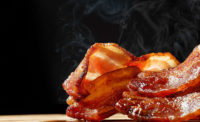Protein processing technologies are becoming more sophisticated, proficient and attractive to meat and poultry plant operators.
Between 2017 and 2025, meat processing equipment revenues will rise from $11 billion to $18.8 billion, a 6.9 percent compound annual growth rate (CAGR), forecasts Allied Market Research, a Portland, Ore.-based market research and advisory firm.
“The industry exhibits an increase in adoption of fully automated technologies and in-built sensor systems,” Allied reports, noting innovations are enhancing machine efficiencies, increasing processing speeds and leading to more adoptions of automated processing systems.
In its 2017 Trends Shaping Meat, Poultry and Seafood Market Segment Report, PMMI, Association for Packaging and Processing Technologies, found 96 percent of survey respondents planned to increase use of automated machinery in the next three to five years for such functions as depalletizing, processing and packaging.
“Machinery will be more automated in the future to keep pace with the growing demand for meat, poultry and seafood,” PMMI reports, adding that the level of automation in each plant will depend on specific manufacturing processes, the availability of labor and total cost.
Process-control enhancements already enable more precise meat cuts, faster line speeds and reductions in human error, while reducing the need to train, manage and continually focus on improving worker performance, says Chris Fuller, owner and operator of Fuller Consulting, a San Diego-based small meat processor consulting firm.
“The ability for processors to eliminate hand cutting in poultry and utilize mechanical separation of carcasses and parts is one of the most impactful technological enhancements to the meat processing industry,” he says. “The significant savings in labor costs on production lines is keeping poultry prices cheap and the cost of other proteins down as a result (of) having to be more competitive with poultry.”
Funding remains an implementation obstacle
Limiting adoption of cutting-edge technologies is a lack of capital, which prevents processors from investing in new equipment and designing or redesigning plants to incorporate the machinery, Fuller says.
“The return on investment on these actions is significant and cannot be ignored,” he says. “But many processors have been operating with slim margins for a long time, making it hard to swallow the typically larger investments required for these new technologies or renovations.”
Equipment with state-of-the-art process controls remains out of reach of many operators because they lack the processing volume to realize relatively quick returns on investment, says Norman Marriott, emeritus professor in the College of Agriculture and Life Sciences at Virginia Polytechnic Institute and State University (Virginia Tech) in Blacksburg.
Processors, nevertheless, should consider the prospect of upgrading any automated process or replacing workers with machinery to enhance operating efficiencies, Fuller says. Automated functions may include meat cutting, carcass breakdown, mixing, portioning, packaging and labeling.
“Operators often push employees to work faster and better, but subsequent fatigue can result in injuries,” he says. “The use of mechanical separation, for instance, reduces these injuries significantly as workers are not as much of a factor on the line.”
Technologies also will evolve as the cost of labor pushes processors to find automated options to help reduce errors and increase yield and product performance, Fuller says.
“Devices will become more precise and accessible to smaller operators, leading to greater product shelf life, increased appeal to consumers and reduced costs,” he says.
Improvements already are occurring in equipment that debones such proteins as chicken, turkey and pork, resulting in faster and cleaner operations with less muscle left on bones, Marriott says.
He says, however, that processors still are seeking technological functions for separating bones from muscles in many beef cuts as the anatomical characteristics make it arduous to efficiently process the carcasses.
“It is very difficult to bone a chuck off of a beef carcass because of the configurations and variations in size and shape,” Marriott says. “There are parts of a poultry carcass that also are a little more difficult to debone, especially the cervical vertebrae. But compared to beef, chicken carcasses are almost like peas in a pod. Poultry has the least variation and pork is in between beef and poultry.”
Robotics become a more viable option
Upgrades to robotic technologies are enabling machines to more effectively handle irregular items and quickly adjust equipment settings to process meats more effectively, says Jorge Izquierdo, PMMI vice president of market development.
“Individual meat slabs are often asymmetrical and can vary from one another in density, shape and size,” he says. “This adaptability is critical for producing the appropriate cuts without wasting product.”
Izquierdo says, however, that processors should thoroughly examine production lines and know what their goals are before taking steps to employ any new technology.
“Companies should implement automated equipment and robotics where those additions will have the most impact,” he says. “Time also is critical. Processors can look to align automated equipment purchases with other changes or additions to the production line to minimize downtime in installation and successfully marry different machines with one another.”
Automated processing technologies, he says, will likely become more modular and adaptable with robotics getting increasingly closer to replicating human movements and decisions. Izquierdo adds that processors also are requesting more user-friendly programming software, including unified controls that allow for easier implementation.
“This overarching shift toward automation has created enormous potential for the meat and poultry industry to boost production and minimize the risk for safety issues, both inside and outside the plant,” he says.
Marriott agrees, noting “technology accelerations will be occurring to enable quicker processing. That includes equipment upgrades, which will eventually enable the converting of meats into ready-to-eat products without going through the chilling process shortly after the animal sacrifice. The best we can do now is the following day.” NP








Report Abusive Comment